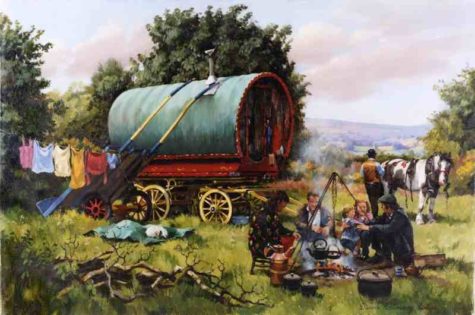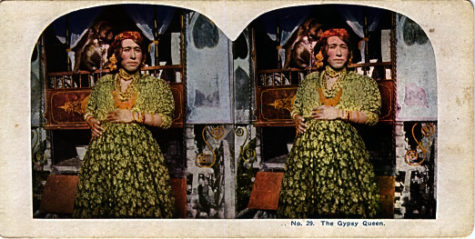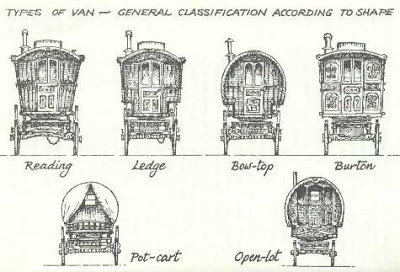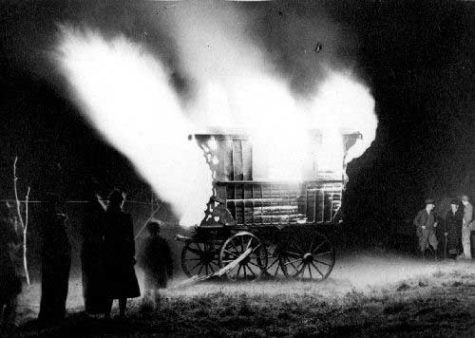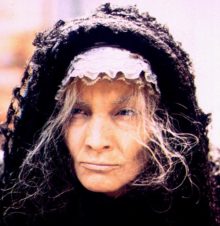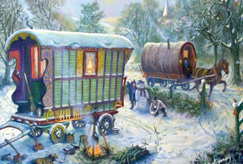Vardo
Gypsy Caravan
I whiled away all the years of my youth
Tending my fields searching for the truth
Gazing past horizons to the west
Hoping I’d see them before my death.
Then one day they rumbled by
A gypsy caravan the color of the sky
Water sparkled as the wheels turned round
Across the river into the town.
Chorus:
There’s a gypsy caravan,
Rolling across the land,
They got singers and a dancing girl
That can make you dream about the wide wide world.
And their captain was a handsome man
He had a sword and what looked like a plan
But there was something wrong in his eyes
Bloodshot and bleary from too many nights
So we stayed up late in that inn
Drinking over our secret sins
Each one wanting what the other one had
We both said the “You’re the lucky man.”
Chorus:
There’s a gypsy caravan,
Rolling across the land,
They got singers and a dancing girl
That can make you dream about the wide wide world.
Late the morning we agreed to trade
Each other’s lives for a later date
Twenty years later again we’d meet
And see if we’d both really found our dreams
So I finally got to see the world
And found for myself a blue eyed girl
We raised three kids in the back of that tent
Rolling through the night they were heaven sent
Chorus:
There’s a gypsy caravan,
Rolling across the land,
They got singers and a dancing girl
That can make you dream about the wide wide world.
Twenty years later again I returned
Only to find out what the we both had learned
He had three kids and a wife of his own
And those green fields had turned into his home
We agreed to go our separate ways
And I’ll not see him til my dying day
The man who gave my dreams to me
Where I found a love for eternity
Chorus:
There’s a gypsy caravan,
Rolling across the land,
They got singers and a dancing girl
That can make you dream about the wide wide world.
Author unknown
Romany or Gypsy Caravans
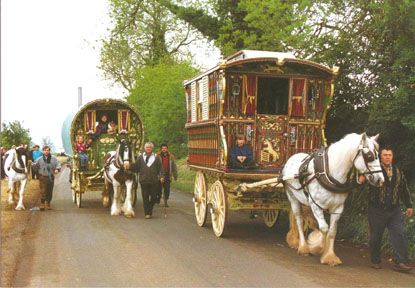
The sight of a Vardo or Romany caravan (often known to the non-travelling population as a ‘gypsy caravan’) is exciting for its rarity and conjures up an unhurried, picturesque pre-industrial lifestyle: images of Wind in the Willows, of a bow-topped roof with extravagantly carved and painted woodwork proceeding slowly behind a large and placid carthorse along narrow hedged lanes.
Referred to by travellers and gypsies as a ‘vardo’ or ‘wagon’, the horse-drawn caravan has been in use in the British Isles since the mid-nineteenth century. Initially made by the travellers themselves, the wagons began to be built by dedicated craftsmen around 1880, when the best examples began to be developed and their distinctive characteristics emerged. Fred Hill, Bill Wright and Duntons are some of the famous builders of the time. This particularly creative period lasted until the 1920s, but the wagons have continued to be made – though on a much more modest scale – until the present day.
There are five main types of vardo: The Brush, The Reading, the Ledge, The Bow Top and the straight-sided ‘Showman’s’ wagon; but within these categories no caravan is exactly the same. There are, however, typical characteristics – the pull-out bed, the child’s cupboard bed, plenty of cupboards and drawers; a little stove on the left-hand side; intricately carved and painted woodwork; pretty floral fabric lining the interior of the roof; and usually a window to the rear. The entrance was either ‘open-lot’ (open, but with curtains or canvas panels for protection) or fixed up with ‘stable’ doors with lace-clad windows.
The inhabitants took great pride in their caravans and enormous pains to decorate both inside and out as beautifully as possible. For the matriarch of the family, the caravan was both a status symbol and embodiment of domestic capability. The best china would be positioned so that it was visible from outside when the curtains were drawn aside or the doors flung open; copper pans would hang sparkling from pegs; lace, embroidery and fringing would embellish every surface and cushion; and the whole place would be spotlessly clean and tidy. Although small, a wagon would have been a permanent home to a travelling family. With plenty of imaginative storage, including a pan cupboard and a rack to the outside rear, life inside would have been perfectly manageable. The small stove heated up the space very effectively, so that the wagon provided a year-round living space. The wagons were light enough to be pulled easily by one dray horse.
On the road, the clip-clop of the horse’s hooves, the gentle sway of the wagon and the scent of fresh air through the front opening must have made it a wonderful form of travel. Many is the story where gypsies have been forced for one reason or another to abandon their wagons and live in ordinary houses, subsequently experiencing unhappiness – even depression, as well as bad cases of claustrophobia.
Horse-trading was an obvious vocation for gypsies, and the Appleby Horse Fair in Cumbria every summer was an essential destination. For many years, decorated wagons and brightly painted wares have made the event on Gallows Hill just outside Appleby one of the most colourful in the country. A place for gypsy families to catch up with each other’s news as well as for deals to be made and fun to be had, The Appleby Horse Fair is one of the largest and most important in romany fairs in Europe. In the 1960s, town councils began to ban fairs (failing in the case of Appleby) and make it very difficult to strike camp on roadsides. This kind of persecution, as well as the increase in motorised traffic, is one of the reasons why the gypsy caravan disappeared so quickly from view.
Nowadays, there is a revived interest in the authentic Vardo, partly for its antique value. Also, entrepreneurs are setting up horse-drawn holidays or letting out caravans to film or TV companies. And small businesses who deal in original and replica vardoes are doing a brisk trade.
From: Cottage Holiday Wales
A Gypsy Queen
The Gypsy Vardo
There are six design types. They are known by various names but are perhaps best called the Reading, the Ledge and the Bow-top. The Bow-top is the most typically Romani; the now extinct Brush – characteristic of brush, broom, rush and wickerwork makers; the Burton – most typically showman; and, the more modern one, the Open-lot.
Being individually built, no two wagons are exactly alike. They vary according to customer requirements, price, skill and location of builder and period. At the same time they have certain exterior features in common, and with few exceptions the interiors conform to a set plan or layout. Thus, the vardo is always one-roomed on four high wheels, with door and movable steps in front (the Brush wagon the only exception), sash windows, a rack called the ‘cratch’ and a pan-box at the rear.
Only minor variations in design occurred after about 1910, with the exception of the more modern Open-lot. Even the home-made vans – ‘peg-knife wagons’, supposedly shaped with the aid of that tool – tended to be along the same lines as the professionally built wagons. It was not uncommon for a traveler to add or remove features of an old wagon, re-mount a body on underworks other than its own, or replace unsound wheels by ones that differed in weight, size or structure from the original, thus altering the proportions.
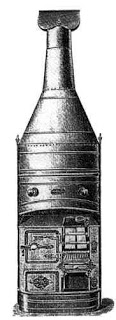 Inside the wagon the atmosphere is snug and homely, and the finer vans have an almost regal splendor. Almost everything one needs is to hand. Even in winter you need never be cold. The fire in the stove, if built up with windows closed for half an hour, will so heat the rails near the roof that they will be too hot to hold. One of the Coopers once claimed that he could bake a cake in his van by stoking up the fire, shutting the windows, and leaving the mixture in the tin on the table!
Inside the wagon the atmosphere is snug and homely, and the finer vans have an almost regal splendor. Almost everything one needs is to hand. Even in winter you need never be cold. The fire in the stove, if built up with windows closed for half an hour, will so heat the rails near the roof that they will be too hot to hold. One of the Coopers once claimed that he could bake a cake in his van by stoking up the fire, shutting the windows, and leaving the mixture in the tin on the table!
Inside the wagon the cabinet work may be either dark red polished mahogany or stained pine, and the walls are grained or scumbled in light-golden brown. In the vans that have had a lot of wear and tear the original wood finish has often been painted or grained over.
Internal layout, which varies little from type to type or van to van, has not changed for a century. The basic needs of the resident are the same and, in such confined space, there is only one sensible way to meet them. The entrance is frontal and half-doored. Through it, and on your immediate left, you find a tall, narrow wardrobe and beneath it perhaps a small brush cupboard.
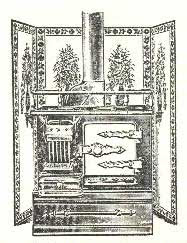 The fireplace stands next, and is always on the left as you enter, for on that side the chimney pipe is in less danger from roadside trees. From a point about two feet above the top of the stove, the fireplace is boxed in to form an airing cupboard. On the front of this cupboard and above the fireplace is a brass-railed shelf and next comes the offside window, and beneath a locker seat for two.
The fireplace stands next, and is always on the left as you enter, for on that side the chimney pipe is in less danger from roadside trees. From a point about two feet above the top of the stove, the fireplace is boxed in to form an airing cupboard. On the front of this cupboard and above the fireplace is a brass-railed shelf and next comes the offside window, and beneath a locker seat for two.
To the right, as you enter, is a bow-fronted corner cupboard; the top part , usually having glass doors, is probably used for displaying china, and the cupboard below for boots and cleaning gear. Opposite the fire there is another locker seat, and of a cold winter’s day it is good to sit there, lean back and place your stockinged feet on the brass guard rail on the front of the stove. Next to the seat is a bow-fronted chest of drawers.
Filling in the back of the van is a two-berthed bed-place, the top bunk just below the rear window, and beneath it are two sliding doors. These in the daytime shut away a second, shorter bed-place in which the children sleep. Light is supplied from a bracket oil-lamp above the chest of drawers, the surface of which is used as a table. More light may come from candles.
©From The English Gypsy Caravan by C.H. Ward-Jackson and Denis E. Harvey 1973 Edition
Home Sweet Home Spell
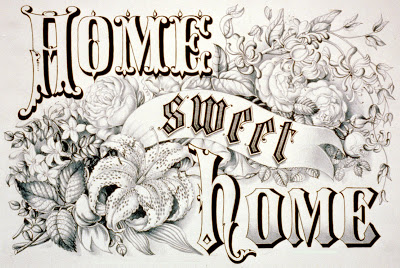
Just as Romanies blessed and protected their vardos, so you can bless your new home and protect it from burglary and fire.
- Sprinkle salt around the perimeter
- Or plant garlic around the boundary.
- You can also pray for a circle of gold light for protection and a circle of blue light for healing to be placed around the home.
Disruptive neighbors who upset the harmony of your home can be tamed quite simply. Place small hand mirrors on windowsills facing their home. These reflect back whatever they are sending out to you if you say, “Return to sender.” If no anger is attached to your actions, your neighbors will respond to your influence without realizing why.
From: The Good Spell Book
Gypsy Funeral
At one time, it was commonly believed that just as the body is a vehicle for the spirit on earth, the vardo is the vehicle for the body on earth. When someone died, their vardo and most of their possessions were burned because their “vehicle for the body” was no longer needed.
Funerals are a very important rite of passage for the Gypsy Traveler community. When a Gypsy dies it is usual for a vigil to be kept over the body, which is kept illuminated until after the time of the funeral. The deceased is usually buried with the owner’s intimate personal possessions such as jewelry and trinkets.
Some Gypsy funerals will attract people from all over the country to pay their respects and floral tributes are usually on a grand scale. Personal items belonging to the deceased such as clothing, bedding and china are usually burnt or destroyed after the funeral. Many years ago, the wagon was very often burnt as well, but this is rarely done today.
